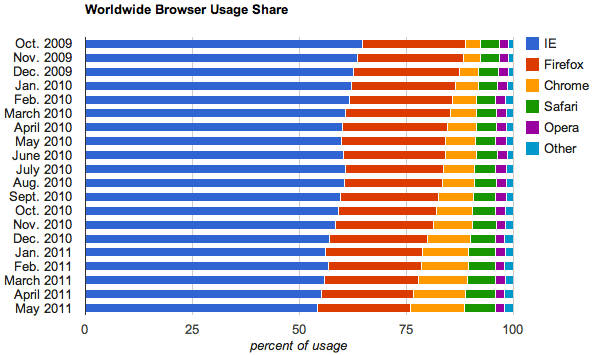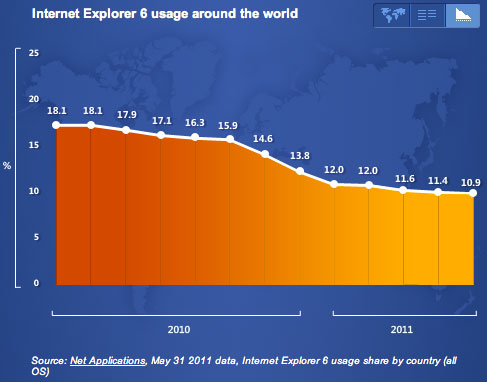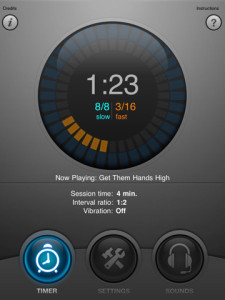The latest statistics about internet browser market shares reveal that both Chrome and IE9 have seen gains and Chrome gained 0.58 per cent in May, reaching 12.52 per cent of the total market, putting it in third place overall. IE9 grew from 2.4 per cent to 4.2 per cent, but this was offset for Microsoft by drops for older versions of IE. The top four browser versions are IE8, IE6, Firefox 4, then Chrome 11 and Firefox 5 is expected later in the month………….
With IE9, Firefox 4 and Chrome 11 all out, the second browser war is only getting fiercer and Internet Explorer dropped 0.84 percentage points, just a tad more than the previous month. Firefox, meanwhile, gained 0.08 percentage points, less than what it lost last month and Chrome gained 0.58 percentage points, making it last month’s biggest winner. Chrome is now used by one out of every eight people on the Internet, new statistics show, but Microsoft’s latest browser is showing signs of steady growth. Chrome usage increased from 11.9 percent in April to 12.5 percent in May, according to statistics released today by Net Applications. The company bases its findings on population-adjusted measurements of visitors to Web sites using its analytics tools. Google has been promoting Chrome widely, taking out ads, publicizing it on YouTube with Lady Gaga songs and sentimental videos, sponsoring developer events, and devoting a full day at Google I/O to the browser and its close relative, Chrome OS. The company’s primary objective: make the Web a faster, more powerful foundation for software and services.
Although the company offers Chrome for free, Google sees it as an indirect revenue source. For one thing, the company benefits when greater activity on the Web leads to more search and display ads. For another, it offers two options that dovetail with Google’s talking point du jour–the lucrative business of building a platform. Chrome OS, sold in laptops and corporate subscriptions, is one; the other is the Chrome Web Store, through which Google hopes developers will sell Web apps. Chrome‘s growth continues a steady trend, along with a couple others: Microsoft‘s Internet Explorer overall lost share, from 55.1 percent to 54.3 percent, and Firefox stayed about level, from 21.6 percent to 21.7 percent. Apple’s Safari has been gaining in usage for months, but it didn’t budge much, moving from 7.2 percent to 7.3 percent. No. 5 Opera dipped from 2.1 percent to 2.0 percent. One important new browser, Firefox 4, outpaced its predecessor in May. It had 10.1 percent of usage compared to 9.1 percent for the earlier version 3.6. Firefox, after years as the top alternative to IE, is itself now an incumbent defending its turf: Chrome, Safari and Opera together account for more usage than Firefox and Chrome has well over half Firefox’s share.
IE9, which emerged in March and embodies Microsoft’s effort to become competitive in the modern browser market, is making steady gains. It rose from 2.4 percent of users in April to 4.2 percent in May, Net Applications said. Microsoft prefers to measure IE9‘s success on a significantly smaller market, Windows 7 machines. IE9 doesn’t run on Windows XP, which is still very widely used, or on Macs or today’s mobile devices. In that market, IE9 was used by 12.2 percent of people in May, Net Applications said. The Internet’s present development is held back by the widespread continuing use of IE6, which doesn’t support a wide swath of modern Web standards and which runs JavaScript programs very slowly. It’s particularly common in China, South Korea, and India, but globally, IE6 usage dropped from 11.4 percent in April to 10.9 percent in May. Microsoft is trying to coax people to upgrade by promoting its IE6 Countdown site, which provides scary-looking banner graphics and reasons to upgrade. Google has made a different choice with its mobile OS, Android. First, Google permits other browsers, and Firefox and Opera Mobile are available for Android, complete with their own Web page rendering engines. Some Android devices even ship with Opera Mini–a “proxy” browser that actually relies on a remote server to process Web pages.
| Browser | April | May | change | relative |
|---|---|---|---|---|
| IE 9.0 | 2.32% | 4.57% | +2.25% | +97.00% |
| IE 8.0 | 30.24% | 29.06% | -1.18% | -3.90% |
| IE 7.0 | 7.82% | 6.39% | -1.43% | -18.30% |
| IE 6.0 | 4.14% | 3.84% | -0.30% | -7.20% |
| Firefox 4.0+ | 7.59% | 14.23% | +6.64% | +87.50% |
| Firefox 3.5+ | 20.90% | 13.95% | -6.95% | -33.30% |
| Firefox 3.1- | 1.19% | 1.12% | -0.07% | -5.90% |
| Chrome | 18.27% | 19.38% | +1.11% | +6.10% |
| Safari | 5.04% | 5.01% | -0.03% | -0.60% |
| Opera | 1.90% | 1.83% | -0.07% | -3.70% |
| Others | 0.59% | 0.62% | +0.03% | +5.10% |
| IE (all) | 44.52% | 43.86% | -0.66% | -1.50% |
| Firefox (all) | 29.68% | 29.30% | -0.38% | -1.30% |
[ttjad keyword=”general”]






